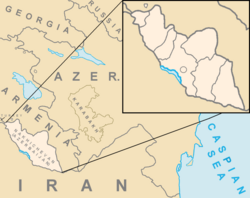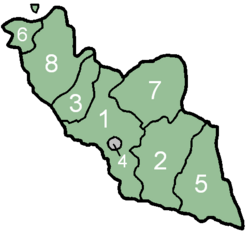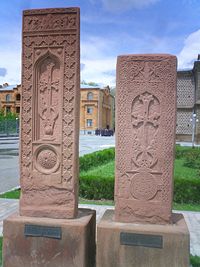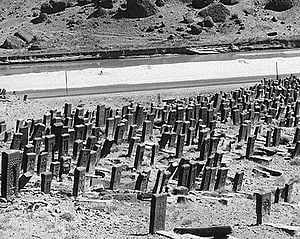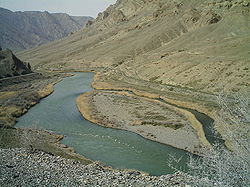Nakhichevan
| Naxçıvan Muxtar Respublikası Nakhichevan Autonomous Republic | |||||
| |||||
|
Location of Nakhichevan | |||||
| Capital | Nakhichevan City | ||||
|---|---|---|---|---|---|
| Largest city | capital | ||||
| Official languages | Azerbaijani | ||||
| Government | |||||
| - Parliamentary Chairman | Vasif Talibov | ||||
| Autonomous republic | |||||
| - Establishment of the Nakhichevan ASSR | February 9, 1924 | ||||
| - Nakichevan Autonomous Republic |
November 17, 1990 | ||||
| Area | |||||
| - Total | 5,5001 km² 2,124 sq mi | ||||
| - Water (%) | negligible | ||||
| Population | |||||
| - 2005 estimate | 372,9001 | ||||
| - Density | 67.8/km² /sq mi | ||||
| Currency | Azerbaijani manat (AZN)
| ||||
| Time zone | EET (UTC+4) | ||||
| - Summer (DST) | EEST (UTC+5) | ||||
| Internet TLD | |||||
The Nakhichevan Autonomous Republic, known simply as Nakhichevan, is a landlocked exclave of Azerbaijan bordering Armenia, Turkey, and Iran.
According to Armenian tradition, Nakhichevan was founded by Noah, of the Abrahamic religions. The oldest material culture artifacts found in the region date back to the Neolithic Age (6000 B.C.E. to 4000 B.C.E.).
This small territory with a population of 372,900 people in 2005 has seen a succession of rulers including Mannae, Achaemenid Persians, Macedonians, Armenians, Sassanid Persians, the Eastern Roman Empire, Arabs, Seljuk Turks, Safavid Persians, Russians and the Soviet Union.
A changing population mixture between Turkic Muslim Azeris and Christian Armenians has been an explosive recipe for ethnic violence.
Geography
Since the territory has been under the rule of numerous powers, variations of the name include "Nachidsheuan", "Nakhijevan", "Nakhchawan", "Nakhjavan" and "Nakhdjevan". According to the nineteenth-century language scholar, Heinrich Hubschmann, the name "Nakhichavan" in Armenian literally means "the place of descent", a Biblical reference to the descent of Noah's Ark on the adjacent Mount Ararat. Hubschmann notes, however, that it was not known by that name in antiquity. Instead, he states the present-day name evolved to "Nakhichevan" from "Naxcavan". The prefix "Naxc" was a name and "avan" is Armenian for "town". According to other versions, the name Nakhchivan derived from the Persian Nagsh-e-Jahan ("Image of the World"), a reference to the beauty of the area. The medieval Arab chronicles referred to the area as "Nashava".
With an area 2124 square miles (5500 square kilometres), or less than one half of the size of the state of Connecticut in the United States, Nakhichevan is an atmospheric, semi-desert region that is separated from the main portion of Azerbaijan by Armenia. Nearly 75 percent of the territory is located at a height of 3280 feet (1000 meters). The Zangezur Mountains make up its border with Armenia while the Aras River defines its border with Iran. It is extremely arid and mountainous. Nakhichevan's highest peak is Mount Kapydzhik 12,808 feet (3904 meters) and its most distinctive is Ilandag (Snake Mountain) at 7923 feet (2415 meters) which is visible from Nakhichevan City. The region has impressive volcanic domes. According to legend, the cleft in its summit was formed by the keel of Noah's Ark as the floodwaters abated.
The climate is continental, becoming semi-desertic in parts of the pre-Arazian plain. Precipitation is low, even in mountain areas. Rain occurs rarely but with intensity, often causing floods due to the sparse vegetation. The only area of forest is located near Bichanak. The region regularly has strong earthquakes, that of 1931 having been particularly severe.
Nakhichevan City, the capital, was an ancient trading centre believed to be founded in the sixteenth century B.C.E. According to a legend, the city was founded by Noah. Nakhchivan city was home to over 60.000 inhabitants in 2007, when it has some industry, centred around glass, furniture, textiles and carpets, aluminum, tobacco and grape processing.
History
According to Armenian tradition, Nakhichevan was founded by Noah, of the Abrahamic religions. The oldest material culture artifacts found in the region date back to the Neolithic Age (6000B.C.E. to 4000 B.C.E.).
The region was part of the states of Mannae (1000 B.C.E.), Urartu and Medes. It became part of the Satrapy of Armenia under Achaemenid Persia circa 521 B.C.E. After Alexander the Great's death (323 B.C.E.) various Macedonian generals such as Neoptolemus tried to take control of the region but ultimately failed and a native dynasty of Orontids flourished until Armenia was conquered by Antiochus III the Great.
Armenian kingdom
In 189 B.C.E., Nakhichevan was part of the new Kingdom of Armenia established by Artaxias I. Within the kingdom, the region of present-day Nakhichevan was part of the Ayrarat, Vaspurakan and Syunik provinces. The area's status as a major trade center allowed it to prosper, though because of this, it was coveted by many foreign powers. According to historian Faustus of Byzantium (4th century), when the Sassanid Persians invaded Armenia, Sassanid King Shapur II (310-380) removed 2000 Armenian and 16,000 Jewish families in 360-370. In 428, the Armenian Arshakuni monarchy was abolished and Nakhichevan was annexed by Sassanid Persia. In 623, possession of the region passed to the Byzantine Empire.
Arabs invade
Beginning in 651, the Arabs organized periodic marauding raids deep into the region, crushing all resistance and attacking Armenian nobles who remained in contact with the Byzantines or who refused to pay tribute. In 705, Armenian nobles and their families were locked into a church at Nakhichevan and by order of the governor, the church was burnt with them inside. Central Asia came under Arab control by the early eighth century and was incorporated into Islamic Caliphate divided between provinces of Mawara'un Nahr and Khorasan. The Arab conquest brought Islam to the region. Eventually, Nakhichevan became part of the autonomous Principality of Armenia under Arab control.
In the eighth century, Nakhichevan was one of the scenes of an uprising against the Arabs led by freedom fighter Babak Khorramdin. Nakhichevan was finally liberated from Arab rule in the tenth century by Bagratid King Smbat I and handed over to the princes of Syunik.
Seljuk Turk conquest
In the eleventh century, the conquering Seljuk Turks became the dominant force in Azerbaijan and laid the ethnic foundation of contemporary Azerbaijanis. In twelfth century, the city of Nakhichevan became the capital of the state of Atabegs of Azerbaijan, also known as Ildegizid state, which included most of Iranian Azerbaijan and significant part of South Caucasus.
The Armeno-Georgian princely house of Zacharids frequently raided the region when the Atabeg state was in decline in the early years of the thirteenth century. It was then plundered by invading Mongols in 1220 and Khwarezmians in 1225 and became part of Mongol Empire in 1236 when the Caucasus was invaded by Chormaqan.
The fourteenth century saw the rise of Armenian Catholicism in Nakhichevan, though by the fifteenth century the territory became part of the states of Kara Koyunlu and Ak Koyunlu.
Persian forced evacuation
In the sixteenth century, control of Nakhichevan passed to the Safavid dynasty of Persia. In 1604, Shah Abbas I Safavi, concerned that the lands of Nakhichevan and the surrounding areas would pass into Ottoman hands, decided to institute a scorched earth policy. He forced the entire local population, Armenians, Jews and Muslims alike, to leave their homes and move to the Persian provinces south of Aras. Many of the deportees were settled in a neighborhood of Isfahan that was named New Julfa since most of the residents were from the original Julfa (a predominantly Armenian town which was looted and burned). The Turkic Kangerli tribe was later permitted to move back under Shah Abbas II (1642-1666) in order to repopulate the frontier region of his realm.
In the seventeenth century, Nakhichevan was the scene of a peasant movement led by Köroğlu against foreign invaders and "native exploiters". In 1747, the Nakhichevan khanate emerged in the region after the death of Nadir Shah Afshar.
Russian conquest
After the last Russo-Persian War (1826-1828) and the Treaty of Turkmanchai, the Nakhichevan khanate passed into Russian possession in 1828. With the onset of Russian rule, the Tsarist authorities encouraged resettlement of Armenians to Nakhichevan and other areas of the Caucasus from the Persian and Ottoman Empires. At that time only 17 percent of its residents were Armenian Christians, while the remainder of the population (83 percent) were Muslims. After resettlement, the number of Armenians had increased to 45 percent while Muslims remained the majority at 55 percent. Friction arose between the Armenian and Muslim populations. The Nakhichevan khanate was dissolved in 1828, its territory was merged with the territory of the Erivan khanate and the area became the Nakhichevan uyezd of the new Armenian oblast, which later became the Erivan Governorate in 1849.
By the turn of the twentieth century in the Sharur-Daralagyoz uyezd, the territory of which would form part of modern-day Nakhichevan, Azeris constituted 70.5 percent of the population, while Armenians made up 27.5 percent. During the Russian Revolution of 1905, conflict erupted between the Armenians and the Azeris, culminating in the Armenian-Tatar massacres.
War and revolution
Around the time of Nakhichevan was the scene of more bloodshed between Armenia and Azerbaijan, both of whom held claims to the area. After the February Revolution in Russia, in 1917, the region was under the authority of the Special Transcaucasian Committee of the Russian Provisional Government, then the Transcaucasian Democratic Federative Republic. When the TDFR was dissolved in May 1918, Nakhichevan, Nagorno-Karabakh, Zangezur (today the Armenian province of Syunik), and Qazakh were heavily contested between the newly formed and short-lived states of the Democratic Republic of Armenia and the Azerbaijan Democratic Republic. In June 1918, the region came under Ottoman occupation, then occupation by the British.
The Aras War
The British proposed a border settlement unacceptable to both Armenians and Azeris. In December 1918, Jafar Kuli Khan Nakhichevanski declared the Republic of Aras in the Nakhichevan uyezd of the former Erivan Governorate assigned to Armenia by the British. The Armenian government sent its troops into the region to take control of it. The conflict soon erupted into the violent Aras War. By June 1919, Armenia gained control over Nakhichevan. The fall of the Aras republic triggered an invasion by the Azerbaijani army and by the end of July, Armenian troops were forced to leave Nakhichevan City. Violence erupted between Armenians and Azeris, leaving 10,000 Armenians dead and 45 Armenian villages destroyed. Meanwhile, the British withdrew. Fighting continued between Armenians and Azeris. In March 1920, Armenian forces attacked the disputed territories and by the end of the month, both the Nakhichevan and Zangezur regions came under Armenian control.
Soviet rule
In July 1920, the Eleventh Soviet Red Army invaded and occupied the region, and on July 28 declared the Nakhichevan Autonomous Soviet Socialist Republic with "close ties" to the Azerbaijan SSR. In November, on the verge of taking over Armenia, the Bolsheviks in order to attract public support, promised they would allot Nakhichevan to Armenia, along with Karabakh and Zangezur.
Vladimir Lenin did not agree and called for the people of Nakhichevan to be consulted in a referendum, held in early 1921. In that, 90 percent of Nakhichevan's population wanted to be included in the Azerbaijan SSR as an autonomous republic. The decision to make Nakhichevan a part of modern-day Azerbaijan was cemented March 16, 1921 in the Treaty of Moscow between the Soviet Union and the newly-founded Republic of Turkey. This agreement also called for attachment of the former Sharur-Daralagez uyezd (which had a solid Azeri majority) to Nakhichevan, thus allowing Turkey to share a border with the Azerbaijan SSR. This deal was reaffirmed on October 23, in the Treaty of Kars. So, on February 9, 1924, the Soviet Union officially established the Nakhichevan ASSR. Its consititution was adopted on April 18, 1926.
As part of the Soviet Union, tensions lessened over the ethnic composition of Nakhichevan or any territorial claims regarding it. Instead, it became an important industrial area for mining salt, and junctions on the Moscow-Tehran, and Baku-Yerevan railway lines. It was strategically important during the Cold War, sharing borders with both Turkey (a NATO member) and Iran (a close ally of the west until the 1979 Iranian Revolution).
Under Soviet rule, education and public health began to improve. The ethnic mix between Armenians and Azeris changed dramatically, as Nakhichevan's Armenian population gradually emigrated to the Armenian SSR. In 1926, 15 percent of region's population was Armenian, but by 1979 this number had shrunk to 1.4 percent. The Azeri population, meanwhile increased substantially with both a higher birth rate and immigration (going from 85 percent in 1926 to 96 percent by 1979.
Armenians in Nagorno-Karabakh noted similar demographic trends and feared an eventual "de-Armenianization" of the area. In the summer of 1989, the Azerbaijan SSR instigated a partial railway and air blockade against Armenia, as a response to attacks by Armenian forces on trains entering from Azerbaijan. This effectively crippled Armenia's economy, as 85 percent of goods arrived by rail. In response, Armenia closed the railway to Nakhichevan, thereby strangling the exclave's only link to the rest of the Soviet Union. Further unrest appeared in Nakhichevan in December 1989 as its Azeri inhabitants moved to dismantle the Soviet border with Iran to flee the area and meet their cousins in northern Iran. The Soviet leadership accused the Azeris of "embracing Islamic fundamentalism".
Independence
On January 20, 1990, the Soviet army cracked down on an Azeri pro-independence protest in Baku, Azerbaijan SSR, an event referred to as Black January. Heydar Aliyev, who was later to become president of Azerbaijan, returned to Nakhichevan, his birthplace, in 1990. He had been ousted from his position in the Politburo by Mikhail Gorbachev in 1987. Soon elected to the Supreme Soviet. Aliyev resigned from the Communist Party of the Soviet Union, and after the failed August 1991 coup against Gorbachev, he called for independence for Azerbaijan. He denounced Ayaz Mütallibov, the first post-Soviet President of Azerbaijan, for supporting the coup. In late 1991, Aliyev consolidated his power base as chairman of the Nakhichevan Supreme Soviet and asserted Nachichevan's near-total independence from Baku.
Nakhichevan became a scene of conflict during the Nagorno-Karabakh War. On May 4, 1992, Armenian forces shelled the area's Sadarak rayon. The heaviest fighting took place on May 18, when the Armenians captured Nakhichevan's exclave of Karki, a tiny territory through which Armenia's main North-South highway passes. Heydar Aliyev declared a unilateral ceasefire on May 23 and sought to conclude a separate peace with Armenia. A cease-fire was agreed upon.
Despite a cease-fire in place since 1994, Azerbaijan has yet to resolve its conflict with Armenia over the predominantly ethnic Armenian territory. Since the end of the war, Azerbaijan lost control of about 16 percent of its territory including Nagorno-Karabakh itself. As a result of the conflict, both countries faced problems with refugees and internally displaced persons as well as economic hardships.
Government and politics
Nakhichevan, as an “exclave” of Azerbaijan, is one that is geographically separated from the main part by surrounding alien territory. Nakhichevan retains its autonomy as the Nakhichevan Autonomous Republic and is internationally recognized as a constituent part of Azerbaijan governed by its own elected parliament. A new constitution for Nakhichevan was approved in a referendum on November 12, 1995. The constitution was adopted by the republic's assembly on April 28, 1998 and has been in force since January 8, 1999.
Nakhichevan has its own parliament, known as the Supreme Assembly, a cabinet of ministers, and a supreme court. According to the constitution, the President of the Azerbaijan Republic appoints the chairman of the Supreme Assembly, the top official of Nakhichevan, upon the recommendation of the Supreme Assembly. Vasif Talibov, who is related by marriage to Azerbaijan's ruling family, the Aliyevs, served as the chairman of the republic in 2007.
He is known for his authoritarian and largely corrupt rule of the region. Most residents prefer to watch Turkish television as opposed to Nakhichevan television, which one Azerbaijani journalist criticised as "a propaganda vehicle for Talibov and the Alievs.
Economic hardships and energy shortages (due to Armenia's continued blockade of the region in response to the Azeri and Turkish blockade of Armenia) plague the area. There have been many cases of migrant workers seeking jobs in neighboring Turkey. When speaking to British writer Thomas de Waal, the mayor of Nakhichevan City, Veli Shakhverdiev, spoke warmly of a peaceful solution to the Karabakh conflict and of Armenian-Azeri relations during Soviet times. Despite recent deals to obtain more gas exports from Iran, the future of Nakhichevan looks bleak.
Nakhichevan is subdivided into eight administrative divisions. Seven of these are rayons. Its capital, the city (şəhər) of Nakhichevan City is treated separately. The rayons are: Babek, 1; Julfa, 2; Kangarli, 3; Nakhichevan City, 4; Ordubad, 5; Sadarak, 6; Shakhbuz, 7; and Sharur, 8.
International issues
Armenia has accused the government of Azerbaijan of destroying historic Armenian headstones (khachkars) at a medieval cemetery in Julfa, presenting photos and video in support of these charges. Azerbaijan denies these accusations, asserting that the Armenian side started a propaganda campaign against Azerbaijan to divert attention from the destruction of Azerbaijani monuments in Armenia. The Institute for War and Peace Reporting, meanwhile, reported on April 19, 2006 that "there is nothing left of the celebrated stone crosses of Jugha.”
The European Parliament has formally called on Azerbaijan to stop the demolition as a breach of the UNESCO World Heritage Convention. In 2006, Azerbaijan barred the European Parliament from inspecting and examining the ancient burial site, stating that it would only accept a delegation if it visited Armenian-controlled territory as well.
Meanwhile, Nakhichevan's parliament issued a non-binding declaration in the late 1990s recognizing the sovereignty of the Turkish Republic of Northern Cyprus and calling upon Azerbaijan to do so. While sympathetic to the TRNC, Azerbaijan has not followed suit because doing so would prompt Greek Cypriot recognition of the self-proclaimed Nagorno-Karabakh Republic.
Economy
Agriculture is the main activity, and major products include cotton and cotton textiles, grapes, meat, silk, tobacco, and wheat. Although dry, irrigation, developed during the Soviet years has allowed the region to expand into the growing of wheat (mostly grown on the plains of the Aras River), barely, cotton, tobacco, orchard fruits, mulberries, and grapes for producing wine.
Nakhichevan's major industries include the mining of salt, molybdenum, and lead. Other industries include cotton ginning/cleaning, silk spinning, fruit canning, meat packing, and, in the dryer regions, sheep farming. In terms of services, Nakhichevan offers very basic facilities and lacks heating fuel during the winter.
Nakhchivan city has some industry, centered around glass, furniture, textiles and carpets, aluminum, tobacco and grape processing. The government was looking, in 2007, for investment to develop tourism and oil production. Socially, this regional capital is quite sophisticated with its own university and a significant scientific and artistic community. The city has numerous business visitors from Iran, Turkey and Russia.
The city is served by an airport and theoretically has good road and rail links, however the the Nagorno-Karabakh war has made access more difficult contributing to a greater isolation.
As an autonomous exclave of Azerbaijan, Nakhichevan’s GDP, poverty, unemployment and trade statistics are part of Azerbaijan’s statistics. The territory shares all the problems of the former Soviet republics in making the transition from a command to a market economy. Other problems result from the continuing conflict with Armenia over the Nagorno-Karabakh region, and pervasive corruption.
Demographics
As of 2005, Nakhichevan's population was estimated to be 372,900. Ninety eight percent of the population are Azerbaijanis. Ethnic Russians and a minority of Kurds constitute the remainder of the population. The remaining Armenians were expelled by Azerbaijani forces during the conflict over Nagorno-Karabakh as part of the forceful exchange of population between Armenia and Azerbaijan. Life expectancy is assumed to resemble that of Azerbaijan, which was 65.96 years for the whole population in 2007.
Likewise, religion in Nakhichevan is assumed to resemble Azerbaijan, which as a secular country, constitutionally guarantees religious freedom. Azerbaijan is 93.4 percent Muslim and most Azerbaijanis are Twelver Shia Muslim. They represent about 60 percent of the Muslim population. Zoroastrianism goes back to the first millennium B.C.E., and for at least 1000 years remained the predominant religion in Azerbaijan. Today the religion, culture and traditions of Zoroastrianism remains highly respected there, and Novruz continues to be the main holiday.
The Azerbaijani language is a member of the Oghuz subdivision of the Turkic language family. Its closest relatives are Turkish and Turkmen. As a result of the language policy of the Soviet Union, Russian is also commonly spoken as a second language among the urbane.
In Azerbaijani society, men are the breadwinners, although there are no restrictions on women's participation in work and in public life. Women are most respected for their role as mothers, and women in rural areas usually control domestic and ritual life. Marriages are increasingly arranged according the partners' wishes. Economic security is a concern for women. As well as a civil marriage ceremony, some couples marry according to Islamic law. The domestic unit is either a nuclear family, or two generations in one household, tending to include the husbands parents.
The education system reflects its Soviet past, higher education is valued, and literacy levels are high — 98.8 percent aged 15 and over can read and write. Under Soviet rule, the urban merchant class and industrial bourgeoisie lost their wealth. An urban-rural divide is the most significant social stratification, although educational opportunities and principles of equality of the Soviet period altered this.
Culture
Music and the arts are abound in Nakhichevan. In 1923, a musical subgroup was organized at the State Drama Theater (renamed the Dzh. Mamedkulizade Music and Drama Theater in 1962). The Aras Song and Dance Ensemble (established in 1959) is another famous group. Dramatic performances staged by an amateur dance troupe were held in Nakhichiven in the late 19th century. Theatrical art also greatly contributed to Nakhichevan's culture. The creative work of Jalil Mammadguluzadeh, M.S. Gulubekov, and G. Arablinski (the first Azerbaijani film director) are just a few of the names that have enriched Nakhichevan's cultural heritage. [1] The region has also produced noteworthy Armenian artists too such as Soviet actress Hasmik Agopyan. Nakhichevan has also at times been mentioned in works of literature. Nezami, considered a master of Persian literature once wrote:
- که تا جایگه یافتی نخچوان
- Oh Nakhichevan, respect you've attained,
- بدین شاه شد بخت پیرت جوان
- With this King in luck you'll remain.
- که تا جایگه یافتی نخچوان
Famous people from Nakhichevan
Political leaders
- Heydar Aliyev, President of Azerbaijan (1993–2003)
- Abülfaz Elçibay, President of Azerbaijan (1992–1993)
- Rasul Quliyev, human rights activist and speaker of the National Assembly of Azerbaijan (1993–1996)
- Christapor Mikaelian, founding member of the Armenian Revolutionary Federation
- Jafar Kuli Khan Nakhichevanski, khan of the Nakhichevan khanate and the founder of the short-lived Republic of Aras
- Garegin Ter-Harutiunian (Garegin Njdeh), Armenian revolutionary
Religious leaders
- Alexander Jughaetsi (Alexander I of Jugha), Armenian Catholicos (1706–1714)
- Hakob Jughaetsi (Jacob IV of Jugha), Armenian Catholicos (1655–1680)
- Azaria I Jughaetsi, Armenian Catholicos of the Holy See of Cilicia (1584–1601)
Military leaders
- Ehsan Khan Nakhichevanski, Russian military general
- Hussein Khan Nakhichevanski, Russian cavalry general and the only Muslim to serve as General-Adjutant of the Russian Tsar
- Ismail Khan Nakhichevanski, Russian military general
- Kelbali Khan Nakhichevanski, Russian military general
- Jamshid Khan Nakhichevanski, Soviet military general
Writers and poets
- M.S. Gulubekov, writer
- Huseyn Javid, poet
- Jalil Mammadguluzadeh, writer and satirist
- Ekmouladdin Nakhichevani, medeival literary figure
- Hindushah Nakhichevani, medeival literary figure
- Abdurrakhman en-Neshevi, medeival literary figure
- Mammed Said Ordubadi, writer
Others
- Hasmik Agopyan, Soviet Armenian actress
- Simeon Jughaetsi, philosopher
- Aram Merangulyan, director and composer
- Ajami Nakhchivani, architect and founder of the Nakhichevan school of architecture
- Gaik Ovakimian, Soviet spy
Photographs of Nakhichevan
- Nakhichevan01.JPG
The Momine Khatun Mausoleum in Nakhichevan City. - Nakhichevan02.JPG
Ram grave stones dating back several centuries recollected near the Momine Khatun Mausoleum. - Nakhichevan04.JPG
A ram grave stone embedied on concrete construction. - Nakhichevan03.JPG
Statue of Dede Gorgud in Nakhichevan City. - Nakhichevan05.jpg
General view of Ordubad with a range of high mountains in neighboring Iran in the distance. - Nakhichevan06.jpg
Houses of Ordubad photographed near the east bank of Ordubad-chay (also knowm as the Dubendi stream). - Nakhichevan08.jpg
A famous mosque in one quarter of Ordubad. - Nakhichevan09.jpg
A shot of the mountainous terrain of Nakhichevan. - Nakhichevan Mausoleum.jpg
The Yusuf ibn Kuseir Mausoleum in Nakhichevan City.
Footnotes
- ↑ Cite error: Invalid
<ref>tag; no text was provided for refs namedGreatSoviet
External links
- Official website of the Nakhichevan Autonomous Republic
- Armenian History and Presence in Nakhichevan
Template:Administrative divisions of Azerbaijan
| Non-sovereign territories of Europe | |
|---|---|
| Dependent territories and autonomous regions | Adjara1 (Georgia) · Akrotiri and Dhekelia1 (UK) · Åland (Finland) · Azores (Portugal) · Canary Islands (Spain) · Ceuta1 (Spain) · Crimea (Ukraine) · Faroe Islands (Denmark) · Gagauzia (Moldova) · Gibraltar (UK) · Greenland1 (Denmark) · Guernsey (UK) · Jan Mayen (Norway) · Jersey (UK) · Madeira1 (Portugal) · Man, Isle of (UK) · Melilla1 (Spain) · Mount Athos (Greece) · Nakhchivan1 (Azerbaijan) · Svalbard (Norway) · Vojvodina (Serbia) |
| Unrecognized republics and territories | Abkhazia (Georgia) · Nagorno-Karabakh (Azerbaijan)1 · South Ossetia (Georgia) · Transnistria (Moldova) · Turkish Republic of Northern Cyprus (Cyprus)2 |
| Administered by the United Nations | Kosovo (Serbia) |
Credits
New World Encyclopedia writers and editors rewrote and completed the Wikipedia article in accordance with New World Encyclopedia standards. This article abides by terms of the Creative Commons CC-by-sa 3.0 License (CC-by-sa), which may be used and disseminated with proper attribution. Credit is due under the terms of this license that can reference both the New World Encyclopedia contributors and the selfless volunteer contributors of the Wikimedia Foundation. To cite this article click here for a list of acceptable citing formats.The history of earlier contributions by wikipedians is accessible to researchers here:
The history of this article since it was imported to New World Encyclopedia:
Note: Some restrictions may apply to use of individual images which are separately licensed.

